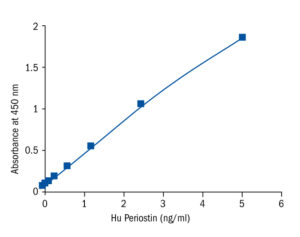Periostin Human ELISA
Periostin was originally isolated as an osteoblast-specific factor that functions as a cell adhesion molecule for pre-osteoblasts and is thought to be involved in osteoblast recruitment, attachment and spreading. Additionally, periostin expression has previously been shown to be significantly increased by both transforming growth factor β1 (TGF-β1) and bone morphogenetic protein 2 (BMP-2). Abnormal expression of periostin is also linked to angiogenesis and metastasis in epithelial tumors. Periostin up-regulation in cancers usually correlates with aggressiveness and/or poor survival.
Research topic
Bone and cartilage metabolism, Cardiovascular disease, Cytokines and chemokines and related molecules, Oncology
Type
Sandwich ELISA, HRP-labelled antibody
Applications
Serum, Plasma, Cell culture supernatant
Storage/Expiration
Store the complete kit at 2–8°C. Under these conditions, the kit is stable until the expiration date (see label on the box).
Calibration Curve

Calibration Range
78–5000 pg/ml
Limit of Detection
15 pg/ml
– Liu Y, Li F, Gao F, Xing L, Qin P, Liang X, Zhang J, Qiao X, Lin L, Zhao Q, Du L. Periostin promotes the chemotherapy resistance to gemcitabine in pancreatic cancer. Tumour Biol. 2016 Sep 30;

